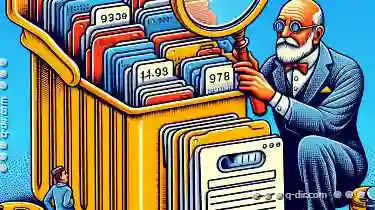With vast amounts of information being generated and stored across various platforms, filtering becomes a crucial aspect for extracting meaningful ...
 insights efficiently. This blog post delves into the world of filters and file filters, exploring their applications in different sectors and how they can be optimized to enhance decision-making processes. In today's digital age, data management is more critical than ever.
insights efficiently. This blog post delves into the world of filters and file filters, exploring their applications in different sectors and how they can be optimized to enhance decision-making processes. In today's digital age, data management is more critical than ever.1. Understanding Filters: A Primer
2. The Evolution of File Filters
3. Applications: From Tech to Retail
4. The Art of Filter Optimization
5. The Last Stand?
6. Conclusion
1.) Understanding Filters: A Primer
Filters are tools used to select or exclude data based on specific criteria. They play a pivotal role in organizing information by sorting out irrelevant data points, making it easier to focus on the essential elements. In various applications such as databases, software programs, and even social media platforms, filters serve to refine search results, enhance user experience, and ensure accuracy in reports and analyses.
2.) The Evolution of File Filters
File filtering refers specifically to methods used to categorize files based on attributes like type, size, date modified, or content. With the advent of digital storage solutions, file management has become exponentially complex. Filtering tools help users navigate through this complexity by allowing them to view only the specific types of files they need at any given time. For instance, image filters can be used in photo editing software to adjust settings based on RGB values, while video filters might focus on brightness and contrast adjustments for better visual quality.
3.) Applications: From Tech to Retail
1. Tech Industry
In the tech sector, filtering is a fundamental part of operations management. Companies use filtering algorithms to manage vast amounts of data from user interactions with their products or services. For example, Netflix uses sophisticated filters to recommend personalized content based on user preferences and viewing history. This not only enhances viewer satisfaction but also increases platform engagement by offering tailored experiences.
2. Retail Industry
In retail, filtering is crucial for businesses aiming to target specific customer segments effectively. E-commerce platforms utilize detailed product filters like price range, color, brand, etc., to help customers quickly find what they are looking for. This not only improves conversion rates but also reduces the burden on support teams by directing potential buyers directly to relevant products.
4.) The Art of Filter Optimization
1. User Experience
Optimizing filters involves more than just technical prowess; it’s about understanding user needs and expectations. Filters should be intuitive, allowing users to navigate through data with minimal confusion. Personalization is key here-offering dynamic filtering based on past behaviors or preferences can significantly enhance the user experience without overloading them with too many options.
2. Performance
Efficiency in data handling is paramount for large-scale applications like databases and cloud storage services. Filtering algorithms must be designed to minimize processing time and resource usage, ensuring swift access to relevant information even as datasets grow larger.
5.) The Last Stand?
The concept of the "perfect match" suggests a state where filtering accurately represents all user needs without overcomplicating the interface or data handling. While significant progress has been made in developing more sophisticated filters, there is always room for improvement. As we move towards an era where AI and machine learning play a pivotal role in data processing, the future of filtering seems bright, promising even more precise and efficient information organization.
6.) Conclusion
Filtering technologies are not just tools but strategic assets that underpin numerous industries from tech to retail. They represent a dynamic balance between technology advancement and user experience. As we continue to refine these tools, it’s crucial to remember that the goal isn't merely to filter data; it’s about empowering users with meaningful insights efficiently. The journey of filtering is ongoing, and as long as there are data challenges, there will be opportunities for innovation in this space.

The Autor: / 0 2025-06-01
Read also!
Page-

The Unintended Consequences of the "Copy All" Button.
Among these tools, operating systems often include a convenient feature known as the "copy all" button. This seemingly simple tool can significantly ...read more

The Little-Known History of File Filtering
From email spam to antivirus software, filters play a crucial role in managing and organizing vast amounts of information. However, few people are ...read more
Why Icon View Stifles Advanced File System Understanding
Among these tools are different views that users can choose from - one of which is the iconic view (also known as icon view). While this type of view ...read more